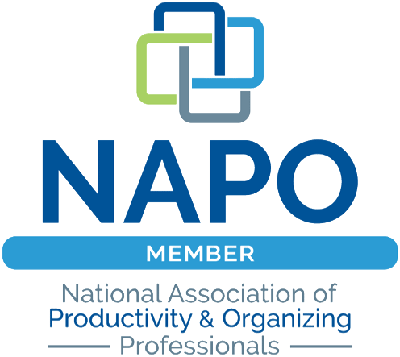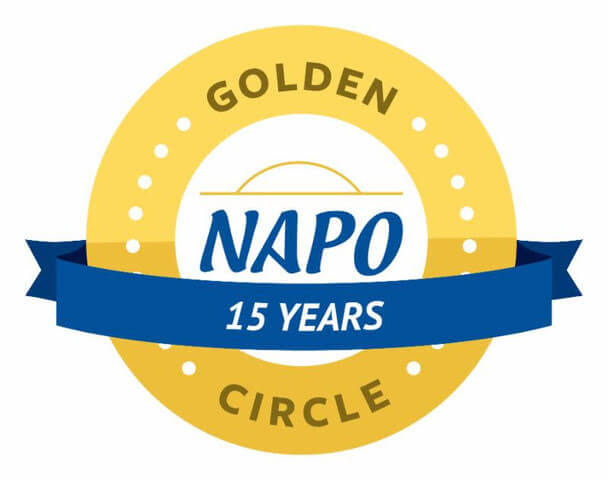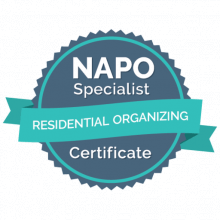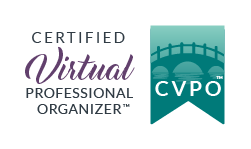Archive for the ‘
Guest Blogger ’ Category
Resolutions. Goals. Intentions. Call it what you will–this is the time of year many people start fresh and decide what they want to do, try, or experience over the next twelve months of their lives. Today’s guest blogger, Professional Organizer Audrey Cupo of A Better Space offers guidance on reflecting on goals of the past and planning for the future…
With the holiday season in full swing and the New Year right around the corner, many people begin to evaluate the past year and start thinking about the future. People think about what they had intended to accomplish in the past year and note the things that just did not get done. Then, they begin to look towards the New Year as a time to reset some goals and plan for the future.
It’s a time for reflection and planning.
For me, I love the prospect of a New Year. It gives me the opportunity to take a look at what I accomplished (or did not accomplish) in the past year, both personally and professionally. It gives me a chance to re-evaluate my priorities. Are there things I wanted to get done but did not? Are the things I intended to do this past year still important?
The New Year gives me a chance to plan for the coming year. What do I want to accomplish THIS year?
I have always been an advocate of writing things down. At this time, especially, I find this true. I like to take some time and make a comprehensive list of projects and “To Do’s”.
That comprehensive list then gets planned out over the coming year. I pick my priorities, one by one, and work on them. When something is completed, I select another.
You might have set some goals last year and found you did not complete them as planned. Why not start fresh?
Do you need to do some home improvement projects? Do you want to lose weight and be healthier? Do you want to get your finances in order or get out of debt? Do you want to improve a relationship with a friend or family member? The choices are endless.
Do yourself a favor. Take some time in the next week or so and reflect on where you have been and where you want to go in your life. Start planning now for the New Year by setting some goals and create a list of the things you want to accomplish.
If getting organized is on your list, seek out the assistance of a professional organizer who can help you to set those goals and get them accomplished.
Enjoy this holiday season and the opportunity for a fresh start in 2013!
Audrey Cupo is a full-time Professional Organizer and sole proprietor of A BETTER SPACE based in Bucks County, PA. She specializes in residential organizing and focuses on helping busy moms and women entrepreneurs with home-based businesses get organized with her in-home services and her “U Can Do It” product line. To sign up for her free newsletter full of great monthly tips, resources and product reviews visit www.4abetterspace.com and for more tips, check out Audrey’s Facebook page.
In 2007, Jack Canfield of ‘Chicken Soup for the Soul’ fame was the Keynote Speaker at the 2007 National Association of Professional Organizers Conference in Minneapolis. Since then, I have subscribed to his newsletter–this article came through my inbox back in April and I thought it would be perfect to post on my blog. Thanks for your words of wisdom, Mr. Canfield!
Clearing Clutter Increases Success
Our physical spaces are filled with dozens of minor distractions and irritants, such as stacks of unread books, scuff marks on the wall, and closets filled with unused items. For most people, these things are like gnats – annoying, but generally insignificant and easily ignored.
Rarely do we recognize them for what they really are – potent threats to our productivity, energy, concentration and peace of mind.
For those of us committed to achieving greater success in our lives, a cluttered physical environment produces three negative consequences:
1. You feel drained. If there are things to do everywhere you look, your mind constantly keeps thinking “I need to fix that.” Eventually, you to feel drained, anxious, irritable, and overwhelmed. To cope, we have to put blinders on and overlook the distractions.
2. Problems spiral out of control. We often overlook irritations for the short-term gain of being able to continue with our daily routine. The danger, however, is that some problems with grow worse with lack of attention. The chip in the windshield that could have been fixed in 30 minutes grows to a crack that requires replacement of the entire windshield.
3. You miss important clues and ideas. It’s impossible to selectively numb out your awareness, ignoring only the minor distractions in your physical space while paying close attention to everything else. This is perhaps the biggest danger for success-minded people. Our most powerful insights often manifest in gut feelings, fleeting thoughts and subtle cues. Numbing out to our cluttered physical environments makes us oblivious to these clues, as well.
Physical Space Impacts Mental Space
Seemingly small irritations and distractions also have a dramatic impact on our mental state. It’s common for people who feel overwhelmed by their physical clutter to go into a state of resignation. When you have a sense that you can’t control the little things – such as quickly finding a stapler when you need it – then it becomes easy to tell yourself that there’s no way you can have the other, bigger things that you want, such as a better car, bigger house, prestigious job, or loving relationship.
The good news is that the same concept works in reverse. When you do recognize that you can control little things, such as the squeak every time you open your front door, you recognize that you can control the bigger things in life, too. Taking action to manage irritations, distractions and clutter builds your confidence in your ability to achieve success, regardless of form.
3 Ways to Deal with Clutter
There are three ways to change any environment: add something to it, take something out of it, or modify it in some form.
Go through your environment and figure out what is irritating and distracting you. Ask yourself how it needs to be fixed. Then think about who you might be able to delegate all or part of the task to. One reason that to-do items accumulate is that we feel like we have to do all of the work ourselves. One of the key strategies for getting more done is to master the art of delegation.
To help you move forward with this process, I’ve posted an “Irritations & Tolerations” worksheet on my blog. Use this tool to identify and create an action plan for handling your irritations and tolerations.
Next, scan your environment to identify elements that need to be removed completely, as well as items that can be brought in to increase the energy in your space. For example, you might find that removing the television or computer from your bedroom makes your sleeping space more relaxing and peaceful. On the other hand, you might find that adding a conference table to your office gives you an inviting place for creative work, while adding plants makes you feel calmer and connected to nature.
Spotting “Good” Clutter
Remember that all clutter is not bad. For many people, clutter is part of their creative process.
When in the midst of creation – such as writing an article, developing a presentation, mapping out a business strategy or creating a product – they pull out resources like books, clippings, articles and notepads. More artistic types might fill their work spaces with tools of their particular trade.
The litmus test to use in determining whether your clutter needs attention is how you feel. If you feel inspired, the clutter is serving you and contributing to your creative expression. If you feel contracted, drained, anxious or stressed, the clutter needs to be tamed.
Environments control us, but it’s important to recognize that as human beings, we are one of the few animals that can control their environments.
Jack Canfield, America’s #1 Success Coach, is founder of the billion-dollar book brand Chicken Soup for the Soul© and a leading authority on Peak Performance and Life Success. If you’re ready to jump-start your life, make more money, and have more fun and joy in all that you do, get FREE success tips from Jack Canfield now at: www.FreeSuccessStrategies.com
Thinking about moving to a smaller home? Maybe you just want to live with less? Today, I’m hosting guest blogger Moreen Torpy of De-Clutter Coach who is on a Virtual Book Tour with her book, “Going Forward: Downsizing, Moving and Settling In.” Read on and learn how downsizing can be a positive and freeing experience.
How do you view the concept of downsizing? Does it bring positive thoughts and feelings or shudders of fear? Have you considered it an opportunity?
It can actually be the opportunity for you to approach the rest of your life with freedom. The opportunity to decide yourself what happens to your belongings. Of course, some will need to be kept, but others can be passed on now to family and friends who value them as much as you do.
Consider inviting family to tell you what they would like from your estate “someday”. Tell them you’re not planning on going anywhere, just planning ahead. You might be surprised that each person values something different, and not necessarily what you believe they will.
If you can live without these items, give them to the recipient now as part of your downsizing process. If you still need them, be sure to indicate who should receive them when the time comes. You might add a codicil to your Will to this effect and attach a photo of the item so there will be no confusion in the future.
This can be the first big step, the key to your downsizing journey. Think carefully about what you will really need in the future. Will you really be hosting big family dinners? If you do, you could borrow the serving pieces or have the new owner bring a contribution to the meal using that dish.
If your plans are to move to a smaller home, apartment or condo, your storage space will shrink accordingly. This might be motivation to reduce the quantity of china, crystal, serving dishes, cookware and other related items such as the tablecloth for the large table that won’t fit into your new place.
Downsizing can be an exciting journey when you look to the future and how you can create new memories, enjoy new experiences, make new friends, and live without the heaviness of owning a large quantity of material goods. There is a great freedom to this. Use the golden key to open the door to your future and enjoy every minute of it.
What will you do to begin your downsizing journey? When will you begin?
~~~~~~~~~~~~~~~~~~~~~~~~~~~~~~~~~~~~~~~~~~~~~~~~~~~
© Moreen Torpy
We would be honored for you to reprint this article. If you do, please include the resource box below with the hyperlinks intact.
~~~~~~~~~~~~~~~~~~~~~~~~~~~~~~~~~~~~~~~~~~~~~~~~~~~
Moreen Torpy is the De-Clutter Coach, a Trained Professional Organizer, Author, and Speaker. Her new book is Going Forward: Downsizing, Moving and Settling In. See www.gofotwarddownsize.com for more about the book including where to purchase it, and www.decluttercoach.ca to learn about her organizing services.
I was going to write a blog post today about procrastination but then I thought, “I’ll just write it tomorrow…’
Ha, ha, ha. That’s just one of many procrastination jokes we’ve all seen on a magnet or a bumper sticker. But, really–procrastination is no joke. It can get in your way when trying to complete tasks or reach your goals and it can mess with your self-esteem.
If you put the ‘PRO’ in ‘Procrastinator,’ then you’re in luck. Moreen Torpy of De-Clutter Coach in Ontario, Canada has written an eye-opening piece about what might be causing you to procrastinate and how to get past it. Don’t put it off until later–read it NOW…
Have you been raised with the admonition to not put off till tomorrow what you can do today?
Have you ever said to yourself or another person, “I’ll put this here just for now?” Then forget you left it there?
Do you postpone doing something because you think you don’t have time to do it perfectly? Then you begin to doubt if you ever could?
What can you identify in your life that leads you to procrastinate? Here are a few ideas and what you might do to stop:
Doubt: You doubt your ability to put something away where it belongs, or if you really don’t know where it belongs, assign a place for the item and always return it there.
Perfectionism: By putting off doing something because you can’t do it perfectly. Let go of perfectionism—it’s not worth the headaches it causes.
Overwhelmed: There’s just too much to do to, for example, organize your space. Refocus and break the project down into smaller pieces then deal with only one piece at a time.
Not in the mood: When will you really be in the mood?
No visible benefit: Does it fit with your long-term goals? If so, do it. If not, let it go. And don’t tell yourself you “should” do it.
You may have more reasons than these. Make a list and write why you feel you can’t deal with them.
Then forgive yourself for procrastinating. In 2010 a group of researchers at Carleton University in Ottawa, Ontario determined that by doing this, your negative emotions about organizing in the future will decrease the possibility of continuing this behavior. Basically, they say to get over it and get to work. How to do this?
Set goals: Make a commitment to a project to work toward. You can focus on smaller bits of the project so it’s more do-able.
Banish boredom: Beware of time stealers. If you’re beginning to feel bored, tackle a project so the boredom doesn’t take hold and pull you into procrastination.
Let go of perfectionism: As long as you complete the project, say organizing your bedroom, it doesn’t have to be perfect to be good. Give yourself permission to change your beliefs. Sometimes “good” is “good enough”.
Dismiss fear of failure: If you’re afraid to do something because you believe you’ll fail at it, procrastination will be happy to take over. And failure will move in with procrastination! That’s failure.
Discard fear of success: If you’re worried that if you do something well, you’ll always be asked to do it. Learn to say “no”. There’s no reason for you to have to do the same thing over and over again.
Think Challenge: When you see a problem as a challenge, your whole energy will change. You will feel in charge, encouraged. And procrastination will cower in fear of you.
Refocus: Change the way you look at things. Turn your thoughts from negative to positive and see how different things are.
By implementing these tips, you can eliminate procrastination from your life and vocabulary. You’ll be on your way to living a productive life.
Moreen Torpy is the De-Clutter Coach, a Trained Professional Organizer, Author, and Speaker. Her new book is Going Forward: Downsizing, Moving and Settling In. See goforwarddownsize.com for more about the book, and decluttercoach.ca to learn about her organizing services.
Take a look at your kitchen. Are the cabinets overflowing? Can you see your countertops? Can you find what you need when you need it? If not, you’re in luck. Our guest blogger and Feng Shui Consultant and Expert, Ann Bingley Gallops of Open Spaces Feng Shui is here today to offer us the steps to take to create a kitchen that nourishes us in more ways than one.
Did you know the kitchen is considered the heart of your home, symbolizing health, wealth and abundance from a Feng Shui perspective?
The food from this room not only sustains you, but also fosters prosperity in your life. Creating meals and cleaning up afterward are important to show how much you care for yourself and your loved ones.
Your kitchen must be an appetizing place, which is why keeping it clean and clutter-free is so important. Sending this message of wealth and abundance will make your life easier and happier, besides!
Here are my Top-Ten Feng Shui Tips for making your kitchen into the “healthy heart” of your home:
1. Clean everything inside & out. And I mean EVERYTHING: drawers and cabinets, appliances, walls and counters. Shelves should be lined with fresh liner paper, and the floor will need a good scrub. This requires you to take everything out of the cabinets, leading naturally to step 2.
2. Assess what you really use. What do you use, need and love in your kitchen? As you remove things from cabinets and drawers, ask yourself, “When did I last use this? What’s what the likelihood I’ll use it in the future?” If you must keep an item you seldom use, put it on a higher shelf or into deep storage.
3. Clear the counters. Small appliances can take over your counter space, preventing you from having adequate space to work comfortably. So remove everything, wipe down all surfaces and replace only the things you use on a daily basis.
4. Put like with like. While sorting through your cabinets, make life easier by putting similar things together. For example, separate sweet baking spices from savory ones, and store coffee filters near your coffee mugs.
5. Adjust shelves to maximize storage space. As you put things back into the cabinets, separate tall items from shorter ones and adjust your cabinets’ shelf-height appropriately.
6. Use “shelf helpers” for convenience and efficiency. Anything from tray racks to lazy susans can make your kitchen easier to navigate and, quite frankly, change your life. Don’t forget to measure your cabinets and drawers before heading to the store!
7. Get good Chi energy flowing by making sure everything works. Broken things must be fixed and doors should swing freely. If you have chipped bowls or glasses, replace them. Be sure to sharpen your knives.
This is a crucial step in Feng Shui — things that are well cared for signify your intention to take the very best care of yourself, too!
8. Recognize the importance of your stove. The stove symbolizes Wealth and Abundance in your life. In Feng Shui, the stove is the centerpiece for the “Heart of Your Home.” It must be treated with particular respect. Keep it clean and use all the burners regularly to draw more positive Chi into your life.
9. Use mirrors to create more wealth. Since the stove burners symbolize Wealth, you can symbolically multiply it by placing a mirror behind the stove. This mirror will also reflect activity behind you, so you can relax and focus on your cooking.
10. Balance the elements. Four of Feng Shui’s Five Elements already exist your kitchen: Fire, Water, Metal and Earth. If Wood is missing, simply bring in a small plant, bowl of fruit or a picture of these. With balanced elements, your space will feel great.
Ann Bingley Gallops is a Feng Shui expert and the owner of Open Spaces Feng Shui in New York City. She offers private Feng Shui consultations for homes, offices and business, helping clients achieve their personal and professional goals by balancing the elements in their spaces.
Her services include long-distance consultations, space-clearing and blessing ceremonies, and Feng Shui design with a modern, practical approach. Ann also works with interior designers, architects and home stagers to maximize the beauty and value of any space.
Ann practices Feng Shui with an MBA from Columbia University, a Practitioner’s Certificate from the Western School of Feng Shui, and Red Ribbon Professional membership in the International Feng Shui Guild.
Today, I’m pleased to welcome guest blogger Cena Block of Sane Spaces. Besides being a Professional Organizer and Mom-Preneur Clarity Catalyst, she is also the President of the Northern New Jersey chapter of the National Association of Professional Organizers. Cena’s talking about a key organizing philosophy—grouping ‘like’ with ‘like.’ Read on to learn more about what she calls, ‘one of the oldest organizing tricks in the book…’
Pattern Recognition is the one differentiating skill set that organized people have – we see and recognize patterns where there aren’t any! It’s why an organizer can walk into a chaotic situation and be successful – we immediately see “like with like” and patterns that work!
What I’ve found with clients in their homes and offices is that for you to be successful, you need to begin to recognize how you create patterns in your environment naturally, in order to create organizing solutions that stick.
One of the oldest organizing tricks in the book is to group ‘like’ things together. Organizers call this: putting “like with like” – or grouping all items that seem to go together, together. The interesting thing about this process is that each of us does this step a little differently.
As part of my community service, I offer a class to area elementary schools called NAPO In The Schools. This class is designed to teach 2nd – 5th graders basic organizing principles. There is an informational segment where the kids are introduced to “Disorganized Drake” who can’t seem to get it together. He frequently loses homework, can’t find supplies, and generally has a really rough time as a typical 4th grader! I ask the students to help Drake by applying simple organizing strategies to his books, his room, his desk and his backpack.
The class ends with an exercise where students are given a bag of school supplies and asked to group them “like with like”. It always fascinates me that some will group them by function (all things you can write with together), by color (all blues go together), by category (all pens, all crayons, all toys), or by some other construct that makes sense to them alone.
What patterns do you recognize? What makes you comfortable? Do you prefer to sort by color, by use, by function, by location? Whatever works for you, is the right answer. Determining which “one of these things is not like the other” is really up to you and the better you get at recognizing your own abilities for pattern recognition – and accept them as so, the quicker you’ll be able to move forward with organizing your items!
Copyright 2011: Cena Block
Need help at home? Download my Products:
Time To Toss It E-Book – http://sanespaces.com/products/organizing/
This is a full color guide that gives guidelines on how long to keep items and when to get rid of them. (There is a whole entire section on how long to keep paper and files.)
Dimensions Workbook – http://sanespaces.com/products/organizing/
This is a self-driven workbook that offers you the support of working with your very own Professional Organizer without the hourly fees.
Get Organized To Keep Your Family Sane Ebook/Audio Tips – http://sanespaces.com/products/organizing/
This e-book and the accompanying weekly audio tips provide nearly 6 months of weekly organizing ideas to implement for your home and family. Whether you have a slew of children, or are kid-free, these tips are modeled after “best practices” that work with real families.

Cena Block is the Owner of Sane Spaces and a Mom-Preneur Clarity Catalyst. She helps people find sanity through clearing their spaces, creating systems, understanding themselves, and getting the support they need for success. Her Slice of Sanity eZine gives subscribers ideas and inspiration to get clear and out from under whatever is stopping them. If you are ready to get sane, you can click here to sign up for a F.R.E.E. e-zine subscription to Slice of Sanity. Learn more from Cena at her Facebook page, on her blog, and on Twitter.
The first steps to getting ANYTHING organized is sorting and purging. That goes for emails, too. Today’s guest blogger is Susana Fonticoba of Home and Office Computer Training. If you use Outlook, you’re in luck. Read to find out how to make your inbox go from overflowing to oh, so empty…
For some people, it is a traumatic prospect to clean out their inbox. “But, I NEED those 2,000 emails,” we’ll hear you say. Not to worry. Let’s take baby steps…
First, in Outlook, sort your emails by whether or not the message contains an attachment (Arrange By | Attachment). Now skim through the attached files and right click the file name, choose Save As, and file it in the appropriate My Documents Folder.
Once the attached files are safely stored in your documents library, check to make sure the body of the email contains no earth shattering information. No? Now delete it. Didn’t that feel good? Do it again – until you get through the all the messages that contain attached files.
Now let’s head over to the Sent Items bucket and this time we’ll change the sort to File Size and choose ‘Smallest’ first. Most likely, these will be comprised of such rip roaring reading material as, “ok, thanks”; or “yes, I’ll be there”; or the ever popular “that’s great!” Even the worst email hoarder has to admit those one-liners can be let loose into email heaven.
After this is done, note how many you’ve deleted by moving over to the Deleted Items folder. Jumpin jiminy! You’ve deleted 1357 emails! Are you brave enough now to empty your deleted items folder? C’mon, I have faith in you!
You’ve done it! Time for a reward and a pat on the back. See–it wasn’t as difficult as you thought. Now, I’m sure you’re pumped to toss some more.
Sort your mail by “From” and see if you can file a bunch of emails from that one client into the folder you made for him/her. Sort your mail by “Subject” and perhaps those 50 emails around the subject of “Christmas Party 2009” can finally be sent off into the light.
Once you’ve gotten the hang of determining that you don’t REALLY need all of those emails, a once a week cleanup will be as easy as hitting ‘Delete.’
Susana Fonticoba is the Founder and Principle of Home and Office Computer Training in Hanover, NJ. She specializes in empowering small business owners with the computer skills and confidence they need to succeed. Follow Susana on Facebook and and Twitter @njpctraining and learn more about computers, social media and technology at her blog, RightClickAdvantage.
Today, I am honored to host our first guest blogger–my organizing colleague, Linda Samuels of Oh, So Organized!. Linda has been a Professional Organizer since 1993 and has recently authored, The Other Side of Organized, a book dedicated to helping readers find a level of order, balance, and organization in their lives. Ever feel like you’re never organized ‘enough?’ Read on…
Organization provides a base to let spontaneity thrive alongside a sprinkling of chaos. Organization is a valuable layer in life, but not an end to itself. Recently, a friend mailed me a Woman’s Day (1996) article I was featured in from 15 years ago. Our daughters were four and six. One of the photos was taken in front of their closet. Aside from noticing their sweet faces, I also saw the organization of their clothes and toys behind them. It was amazing how that one image instantly brought me back to this other time of stuffed animals, building blocks and Candyland.
It made me reflect about the role organization played in our lives. Our girls grew up with a certain level of order. The idea wasn’t to stifle them with it, but merely to be there as a support. Toys were easily accessible. They could reach them and put them away without any difficulties. Art supplies were readily available. Clothes were easy to reach. The order helped to grease the wheels of the day. Having things placed in homes enabled the girls to be spontaneous or deliberate with their play, their schoolwork or whatever they were doing. They had less stress and so did we.
To accommodate their growing interests or needs, we adjusted the organizational systems. Tub toy baskets left and make-up organizers appeared. The dress-up box always existed and still does. After all, you never know when you might need to wear a costume! The layer of organization provided the structure to reduce the stress of life’s details so that we could just fully engage and enjoy ourselves. Less time hunting for things meant more time playing games or painting pictures or dancing around the living room.
Before, I mentioned that the Woman’s Day article made me think about an earlier time. In that same way, my library of photos that cycle as a screensaver on my computer, make me reflect about the moments of our lives. These snapshots are my treasures. In the pictures, I see a lot of laughing, snuggling, celebrating, picnicking, vacationing, hosting of puppies, walking in the woods and gatherings with friends and family. All of these moments and events involved organizing in some way. Our lives were full and busy. Time was precious and still is. So, when we set aside or found the time for fun and for being together, having a level of organization in place enabled us to just go and do that without the stress of hunting for the picnic cooler or the pans to make the birthday muffins.
There was just enough order so we could enjoy ourselves, be spontaneous, let chaos reign briefly and engage completely in the precious moments. Sometimes when people like to tease me by saying, “Oh, Linda. You’re SO organized,” I just smile and think, “I’m just organized enough.”
My wish for you is that you find a level of order that’s right for you so that you can celebrate all of your wonderful moments with as little stress and as much enjoyment as possible.
Linda Samuels, CPO-CD® is a compassionate, enthusiastic professional organizer and founder of Oh, So Organized!, author of The Other Side of Organized and blogger on organizing & life balance at www.theothersideoforganized.com. Follow her on Twitter @LindaSamuels and Facebook at Oh, So Organized!

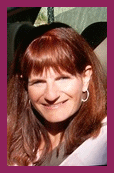


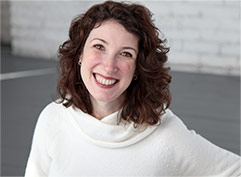
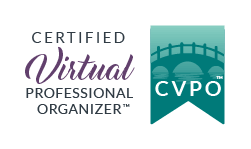
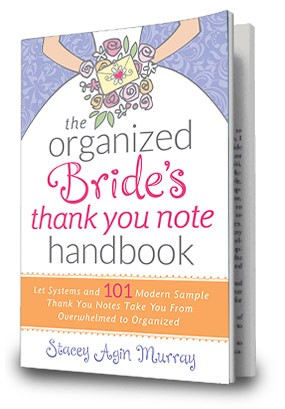


 Contact Stacey to Get Started!
Contact Stacey to Get Started!